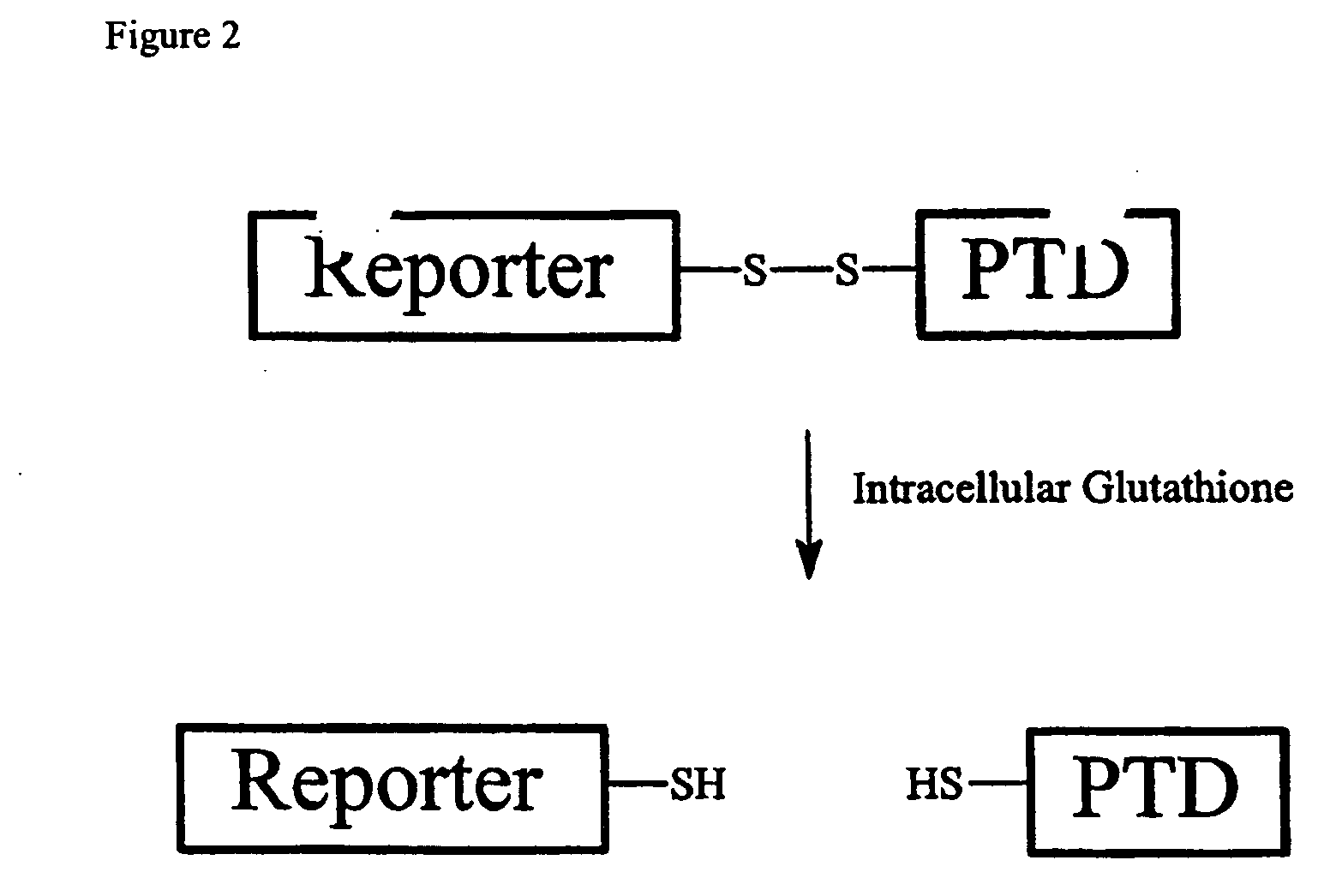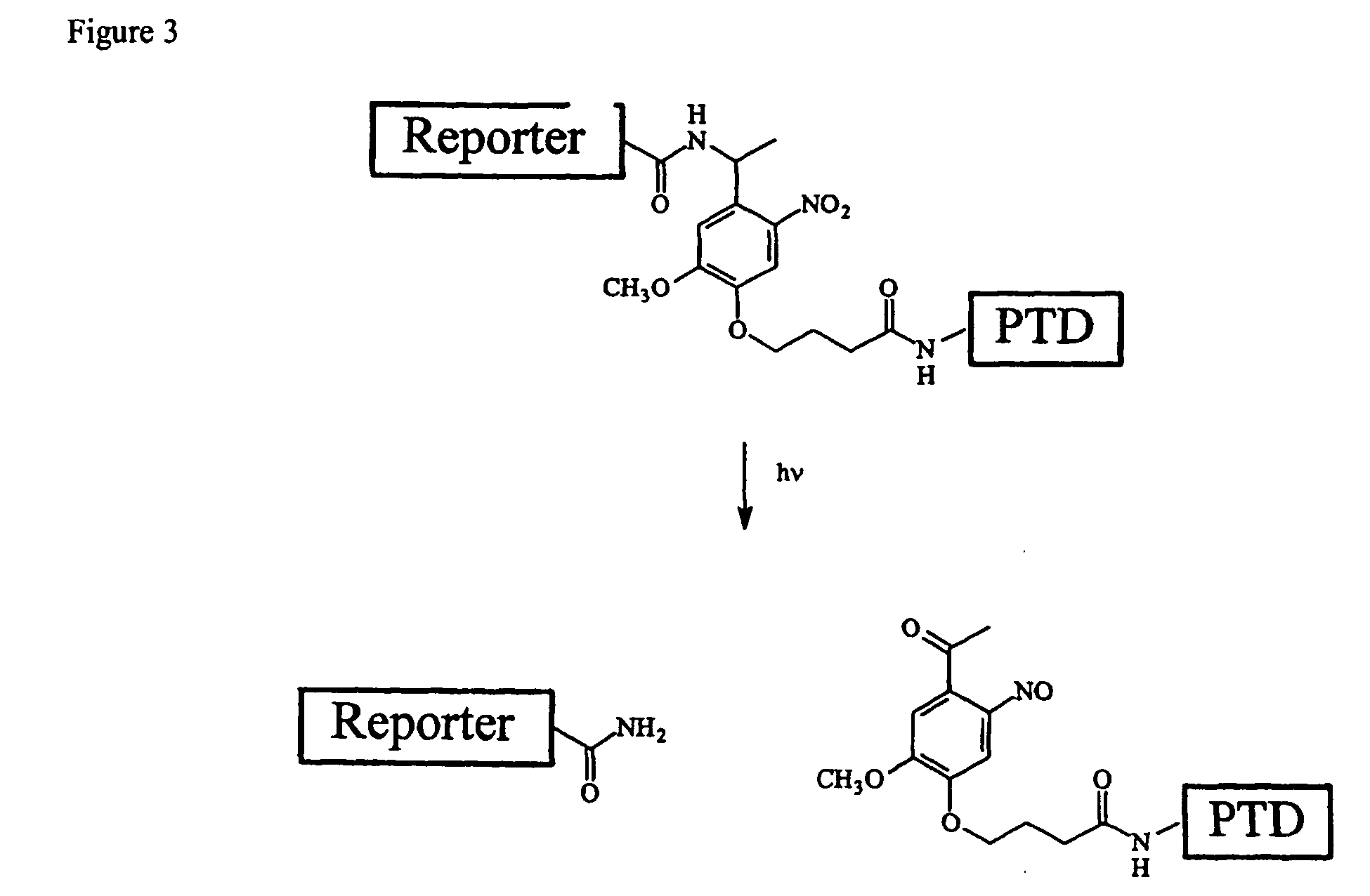Cell-permeable enzyme activation reporter that can be loaded in a high throughput and gentle manner
a reporter and cell-permeable technology, applied in the field of cell-permeable enzyme activation reporter, can solve the problems of hampered cellular mechanism study and diagnosis, unable to meet the intimidating terminology, and the introduction of these molecules is not without significant cos
- Summary
- Abstract
- Description
- Claims
- Application Information
AI Technical Summary
Problems solved by technology
Method used
Image
Examples
example 1
Characterization of TAT(49-57) Conjugated to a Substrate Peptide
[0125] To determine whether a kinase substrate linked to TAT(49-57) was accessible to cytosolic enzymes, rat basophilic leukemia (RBL) cells were incubated with 1 μM calcium-calmodulin dependent kinase II peptide substrate (F-CamKII; SEQ ID NO:11) conjugated to TAT(49-57)(SEQ ID NO:2) through a peptide bond (F-CamKII-TAT; SEQ ID NO:12). To determine if F-CamKII-TAT (SEQ ID NO:12) is phosphorylated by its target kinase, CamKII, cells were loaded with F-CamKII-TAT and then their contents analyzed for phosphorylated F-CamKII using the Cell Activity by Capillary Electrophoresis (CACE) (also known as LMS or Laser Micropipet System, see Methods, below). With the CACE, a single cell can be rapidly lysed and the cellular contents loaded with nearly 100% efficiency into a capillary exceptionally quickly (33×10−3 seconds) (Sims, Meredith et al. 1998; Meredith, Sims et al. 2000; Li, Sims et al. 2001). Together with cell lysis, el...
example 2
Characterization of Substrate Peptides Conjugated to TAT(49-57) by a Disulfide Bond
[0129] Previous investigators developed cleavable PTD-cargo conjugates by engineering a disulfide linkage between the two domains (Stein, Weiss et al. 1999; Hallbrink, Floren et al. 2001). In the oxidative extracellular environment, the disulfide bond remained intact, but in the reductive intracellular environment, the disulfide bond quickly reduced releasing the cargo from the PTD (Meister 1989; Hallbrink, Floren et al. 2001). TAT(49-57)(SEQ ID NO:2) was conjugated via a disulfide bond to cysteines added to substrate peptides for CamKII (F-CamKII-C; SEQ ID NO:13) or PKB (F-PKB-C; SEQ ID NO:14), denoted F-CamKII-C-SS-TAT (SEQ ID NO:15) and F-PKB-C-SS-TAT (SEQ ID NO:16), respectively. The TAT(49-57)-Conjugated substrates were incubated with cells (HT1080 or HT1080 / PTEN cells) and the contents of the cells were analyzed by the CACE. HT1080 cells have constitutive PKB activity due to a mutated allele of...
example 3
Phosphorylation of Substrate Peptides Delivered by a Disulfide-Linked TAT(49-57)
[0132] To determine whether the detached peptide substrates were in the cytosol and accessible to kinases, the intracellular phosphorylation of the translocated cargo was studied. In the initial experiment, F-CamKII-C-SS-TAT (SEQ ID NO:15) at 750 nM extracellular concentration was loaded into HT1080 cells. The cells were incubated with ionomycin (500 nM) for 15 min to increase the intracellular concentration of free Ca2+ and activate the CamKII enzyme (Worrell and Frizzell 1991). The electrophoretic traces from these cells displayed a second peak in addition to the peak of due to the non-phosphorylated F-CamKII-C. The migration time of the second peak was identical to that of phosphorylated F-CamKII-C loaded into cells. 52+3% (mean±SEM) (n=5) of the F-CamKII-C was phosphorylated as determined by comparison of the peak areas. At least half of the F-CamKII-C was in the cytosol and accessible to the kinase...
PUM
| Property | Measurement | Unit |
|---|---|---|
| Fluorescence | aaaaa | aaaaa |
| Chemiluminescence | aaaaa | aaaaa |
| Phosphorescence quantum yield | aaaaa | aaaaa |
Abstract
Description
Claims
Application Information
 Login to View More
Login to View More - R&D
- Intellectual Property
- Life Sciences
- Materials
- Tech Scout
- Unparalleled Data Quality
- Higher Quality Content
- 60% Fewer Hallucinations
Browse by: Latest US Patents, China's latest patents, Technical Efficacy Thesaurus, Application Domain, Technology Topic, Popular Technical Reports.
© 2025 PatSnap. All rights reserved.Legal|Privacy policy|Modern Slavery Act Transparency Statement|Sitemap|About US| Contact US: help@patsnap.com



